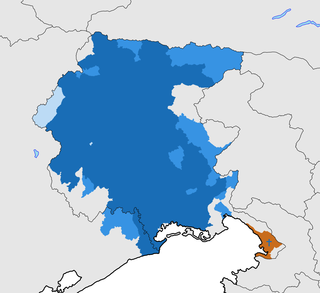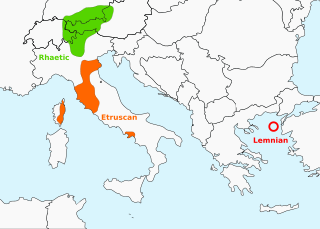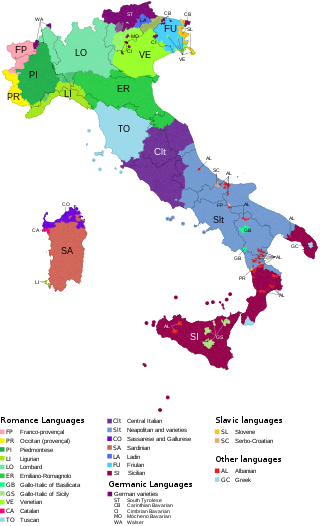
The Italic languages form a branch of the Indo-European language family, whose earliest known members were spoken on the Italian Peninsula in the first millennium BC. The most important of the ancient languages was Latin, the official language of ancient Rome, which conquered the other Italic peoples before the common era. The other Italic languages became extinct in the first centuries AD as their speakers were assimilated into the Roman Empire and shifted to some form of Latin. Between the third and eighth centuries AD, Vulgar Latin diversified into the Romance languages, which are the only Italic languages natively spoken today, while Literary Latin also survived.

Romansh is a Gallo-Romance language spoken predominantly in the Swiss canton of the Grisons (Graubünden). Romansh has been recognized as a national language of Switzerland since 1938, and as an official language in correspondence with Romansh-speaking citizens since 1996, along with German, French, and Italian. It also has official status in the canton of the Grisons alongside German and Italian and is used as the medium of instruction in schools in Romansh-speaking areas. It is sometimes grouped by linguists with Ladin and Friulian as the Rhaeto-Romance languages, though this is disputed.

Ladin is a Romance language of the Rhaeto-Romance subgroup, mainly spoken in the Dolomite Mountains in Northern Italy in the provinces of South Tyrol, Trentino, and Belluno, by the Ladin people. It exhibits similarities to Romansh, spoken in Switzerland, as well as Friulian, spoken in north-east Italy.

Trentino-Alto Adige/Südtirol is an autonomous region of Italy, located in the northern part of the country. The region has a population of 1.1 million, of whom 62% speak Italian as their mother tongue, 30% speak South Tyrolean German and several foreign languages are spoken by immigrant communities. Since the 1970s, most legislative and administrative powers have been transferred to the two self-governing provinces that make up the region: the province of Trento, commonly known as Trentino, and the province of Bolzano, commonly known as South Tyrol. In South Tyrol, German remains the sizeable majority language.

The Gallo-Romance branch of the Romance languages includes in the narrowest sense the langues d'oïl and Franco-Provençal. However, other definitions are far broader and variously encompass the Occitan or Occitano-Romance, Gallo-Italic or Rhaeto-Romance languages.

Friulian or Friulan is a Romance language belonging to the Rhaeto-Romance family, spoken in the Friuli region of northeastern Italy. Friulian has around 600,000 speakers, the vast majority of whom also speak Italian. It is sometimes called Eastern Ladin since it shares the same roots as Ladin, but over the centuries, it has diverged under the influence of surrounding languages, including German, Italian, Venetian, and Slovene. Documents in Friulian are attested from the 11th century and poetry and literature date as far back as 1300. By the 20th century, there was a revival of interest in the language.
The Istriot language is a Romance language of the Italo-Dalmatian branch spoken by about 400 people in the southwestern part of the Istrian peninsula in Croatia, particularly in Rovinj and Vodnjan. It should not be confused with the Istrian dialect of the Venetian language or the more distantly related Istro-Romanian, a variety of Eastern Romance.

Rhaetic or Raetic, also known as Rhaetian, was a Tyrsenian language spoken in the ancient region of Rhaetia in the eastern Alps in pre-Roman and Roman times. It is documented by around 280 texts dated from the 5th up until the 1st century BC, which were found through northern Italy, southern Germany, eastern Switzerland, Slovenia and western Austria, in two variants of the Old Italic scripts. Rhaetic is largely accepted as being closely related to Etruscan.

The languages of Italy include Italian, which serves as the country's national language, in its standard and regional forms, as well as numerous local and regional languages, most of which, like Italian, belong to the broader Romance group. The majority of languages often labeled as regional are distributed in a continuum across the regions' administrative boundaries, with speakers from one locale within a single region being typically aware of the features distinguishing their own variety from one of the other places nearby.

Italo-Western is, in some classifications, the largest branch of the Romance languages. It comprises two of the branches of Romance languages: Italo-Dalmatian and Western Romance. It excludes the Sardinian language and Eastern Romance.
Fornes is the dialect native to Forni di Sopra and Forni di Sotto, two villages which, from AD 1300 to AD 1700, were governed separately from the surrounding areas by the Savorgnani family of Venice and known as 'I Forni Savorgnani'.

Friulians, also called Friulans or Furlans, are an ethnolinguistic minority living primarily in Italy, with a significant diaspora community.

The Romansh people are a Romance ethnic group, the speakers of the Romansh language, native to the Swiss canton of Grisons (Graubünden).

Western Romance languages are one of the two subdivisions of a proposed subdivision of the Romance languages based on the La Spezia–Rimini Line. They include the Gallo-Romance and Iberian Romance branches. Gallo-Italic may also be included. The subdivision is based mainly on the use of the "s" for pluralization, the weakening of some consonants and the pronunciation of “Soft C” as /t͡s/ rather than /t͡ʃ/ as in Italian and Romanian.

The Raeti were a confederation of Alpine tribes, whose language and culture was related to those of the Etruscans. Before the Roman conquest, they inhabited present-day Tyrol in Austria, eastern Switzerland and the Alpine regions of northeastern Italy. After the Roman conquest, the province of Raetia was formed, which included parts of present-day Germany south of the Danube.

Vallader is a variety of the Romansh language spoken in the Lower Engadine valley of southeast Switzerland, between Martina and Zernez. It is also used as a written language in the nearby community of Val Müstair, where Jauer is spoken. In 2008, schools in the Val Müstair switched from Vallader to Rumantsch Grischun as their written language, but switched back to Vallader in 2012, following a referendum.

Tyrol is a historical region in the Alps of Northern Italy and western Austria. The area was historically the core of the County of Tyrol, part of the Holy Roman Empire, Austrian Empire and Austria-Hungary, from its formation in the 12th century until 1919. In 1919, following World War I and the dissolution of Austria-Hungary, it was divided into two modern administrative parts through the Treaty of Saint-Germain-en-Laye:

Ladinia is a neologism used to describe an Alpine region in the Dolomites mountain range of Northern Italy, divided between the Italian provinces of Belluno, South Tyrol, and Trento. The area takes its name from its inhabitants, the Ladin people, a Romance-speaking ethnic group. Their Ladin language is generally considered a Rhaeto-Romance language, though there is a scientific debate if it forms part of a wider northern Italian dialect continuum.

The Ladins are an ethnic group in northern Italy. They are distributed in several valleys, collectively known as Ladinia. These include the valleys of Badia and Gherdëina in South Tyrol, of Fassa in the Trentino, and Livinallongo and Ampezzo in the Province of Belluno. Their native language is Ladin, a Rhaeto-Romance language related to the Swiss Romansh and Friulian languages. They are part of Tyrol, with which they share culture, history, traditions, environment, and architecture.

The Questione Ladina is a controversy over whether the Romance languages of Romansh, Ladin and Friulian form a proper language subfamily or should rather be regarded as a part of a wider Northern Italian dialect continuum. Both the idea of a distinctive language sub-family and the denial of a Ladin unity still have strong proponents, the former especially among Swiss, German and Austrian, the latter among Italian linguists. The issue has political implications beyond the linguistic controversy, as the areas involved have been subjects of territorial disputes, especially during the first half of the 20th century.



















